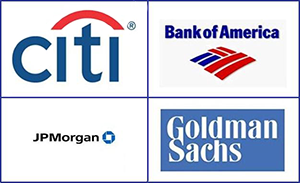Courtesy of Pam Martens
 Several early warning signs emerged in the stock market yesterday. The tech-heavy Nasdaq Composite Index closed at a record high but every major Wall Street bank with large exposures to derivatives closed in the red yesterday. Leading the decliners were Deutsche Bank with a loss of 1.61 percent; Morgan Stanley closed down 1.49 percent; Bank of America lost 0.95 percent while Citigroup, Goldman Sachs and JPMorgan Chase were in the red by less than one percent.
Several early warning signs emerged in the stock market yesterday. The tech-heavy Nasdaq Composite Index closed at a record high but every major Wall Street bank with large exposures to derivatives closed in the red yesterday. Leading the decliners were Deutsche Bank with a loss of 1.61 percent; Morgan Stanley closed down 1.49 percent; Bank of America lost 0.95 percent while Citigroup, Goldman Sachs and JPMorgan Chase were in the red by less than one percent.
But the red ink didn’t stop there. Five of the seven U.S. insurance companies that were singled out in the 2017 Financial Stability Report from the U.S. Treasury’s Office of Financial Research also closed in the red yesterday. The five insurers showing losses of less than one percent were Ameriprise Financial, Hartford Financial Services Group, Lincoln National Corp., Prudential Financial and Voya Financial. Two other insurers with hefty derivative exposure to Wall Street who eked out a few pennies gain yesterday were AIG and MetLife.
The 2017 Financial Stability Report included this cautionary text:
“…some of the largest insurance companies have extensive financial connections to U.S. G-SIBs [Global Systemically Important Banks] through derivatives. For some insurers, evaluating these connections using public filings is difficult. Insurance holding companies report their total derivatives contracts in consolidated Generally Accepted Accounting Principles (GAAP) filings. Insurers are required to report more extensive details on the derivatives contracts of their insurance company subsidiaries in statutory filings, including data on individual counterparties and derivative contract type. But derivatives can also be held in other affiliates not subject to these statutory disclosures, resulting in substantially less information about some affiliates’ derivatives than required in insurers’ statutory filings.”
The scariest black holes according to the report are occurring at MetLife, Prudential Financial and, believe it or not, AIG – the insurer that blew itself up with Wall Street derivatives in 2008 and required a $185 billion taxpayer backstop.
The 2017 Financial Stability Report under the Trump administration’s Treasury Department has scrubbed some of the granular details that appeared in the 2016 Financial Stability Report. That report should have sent the U.S. Senate Banking and House Financial Services Committees into emergency session. What we’ve gotten instead under the Trump administration is deregulation of Wall Street at a time of unprecedented peril.
…



